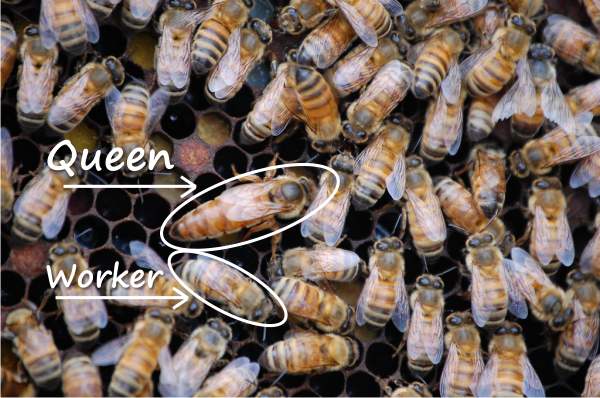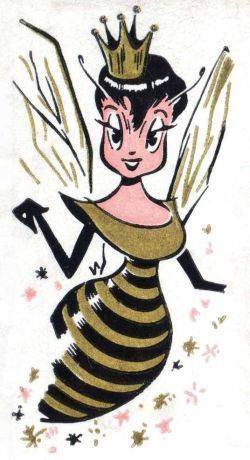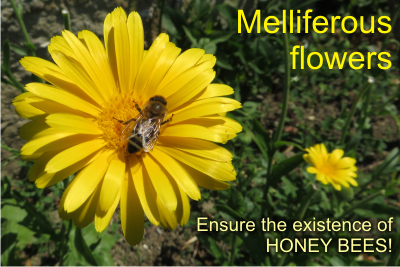Is the honey bee queen really royalty? Is she the one that rules? Will see.
Some say the queen is the most important member in the hive. The truth is that, just like in our human business companies, nobody is irreplaceable! And neither is the queen in that perfectly organized, feminine society of a hive.
How many queens are there in a hive?
There is only one queen in a colony. At a time. With the exception of the short periods during swarming preparations or supersedure (the act of replacing a failing queen).
When a new queen is born, she locates other virgin queens and eliminates them one at a time. If by any chance, 2 virgin honey bee queens emerge simultaneously, they fight each other to the death.
How does a queen bee look like?
 It’s easy to distinguish a queen from other members of the colony, because her body is normally much longer than either the drone’s or worker’s. Especially during the main egg-laying period when her abdomen is greatly elongated. The thorax and the head are almost the same as of the other bees, the thorax is slightly larger than that of a worker and the head a little smaller.
It’s easy to distinguish a queen from other members of the colony, because her body is normally much longer than either the drone’s or worker’s. Especially during the main egg-laying period when her abdomen is greatly elongated. The thorax and the head are almost the same as of the other bees, the thorax is slightly larger than that of a worker and the head a little smaller.
Her wings cover only about two-thirds of her abdomen, whereas the wings of both workers and drones nearly reach the tip of their abdomens when folded.
She doesn’t have pollen baskets, nor functioning wax glands.
She has a stinger which is curved and longer than that of the worker, but it has fewer and shorter barbs. It doesn’t sting people, as she doesn’t leave the hive, except for the nuptial flight. She uses her sting mostly to protect the colony from the enemies.
How is her brood stage?
When bees raise a new queen, they first prepare a special cell, spacious, like a cup, placed with the opening down. They compel the old queen to lay eggs in such cells and the nurse bees make sure that they have lots of royal jelly, even superfluous. Royal jelly is going to feed the queen larvae until capping. Those cells are similar to those of large and oblong acorns.
Queen bees will be larvae for only 5.5 days.
If she is strong and acceptable to the workers she will fight and kill any other virgin queens, as they emerge from their cells. She will then stay in the hive for about a week while her wings strengthen and then leave the hive to mate with drones in flight.
In full activity of laying eggs, in spring-summer, the queen weighs between 250 and 280 milligrams.
A queen can live up to 8 years, but it is efficient only in the first year or two, after which she needs to be changed. In June, she can lay even 3000 eggs in 24 hours. In this intense period the queen is carefully groomed and well fed by the bees in her suite.
In winter some hives are dying from lack of food, yet the queen is the last to die, being nourished by her attendants with the last drop of honey.
The mating flight
The queen attends only one mating flight. In order to avoid inbreeding, a queen flies a considerable distance from her colony to mate, at a drone congregation site, where thousands of males wait.
First, she circles the hive to orient herself to its location. Then leaves the hive unattended for about 15 minutes, usually in the afternoon, and mates with the drones in flight, at an altitude above 20 feet. Drones are able to find and recognize the queen by her chemical odor (pheromone), but they also locate a queen by sight.
Queens mate with usually 12 drones in each mating flight (though sometimes there can be up to 40 drones), storing the males’ sperm in her spermatheca. The drones will die soon after that.
A recent study published by sciencedaily.com says that “For Honey Bee Queens, Multiple Mating Makes Her Attractive To Workers”. This means it’s not the same if the queen mates with 8 drones or with 12 drones. Of course, the number of eggs she will be able to lay will be bigger if there were more drones, but somehow, the workers know about their number right from the beginning.
The study was done in October 2007 and proved that the number of partners appears to be a key factor in making the queen attractive to the worker bees of a colony. The more partners, the more attractive the queen is and the longer her reign is likely to be. In the study, the worker bees paid more attention to the multiply inseminated queens. Worker bees demonstrate what is known as a “retinue response” to their queen; they lick her and rub their antennae on her. The retinue response to the multiply inseminated queens was more pronounced.
The explanation? Here it is: “Like many animals, honey bees use pheromones to communicate. When Richard analyzed pheromone produced in the mandibular gland of honey bee queens, she found that pheromone composition changes dramatically after queens mate and that the number of times the queen mates appears to be a key factor in determining the extent of pheromone alteration. Richard added that when worker bees were exposed to pheromone from queens inseminated with semen from one drone and queens inseminated with semen from multiple drones, the workers showed a preference for the pheromone from the multiply inseminated queens.”
The queen’s sperm reserves allow her to lay millions of eggs throughout her lifetime. Although a queen can lay up to 2,000 eggs a day during active seasons, the amount and pace at which a queen lays her eggs is greatly controlled by weather, food availability and the particular habits of her subspecies of honey bee. The queen’s fertilized eggs become female workers or future honey bee queens. The queen’s unfertilized eggs develop into male honeybees, or drones.
If bad weather delays the queen’s mating flight for more than 20 – 30 days, she loses her ability to mate and will only be able to lay unfertilized eggs, which result in drones.
What’s so special about this queen?
The queen has two main functions:
![]() Because she is the only sexually developed female, her primary function is reproduction. She produces both fertilised and unfertilised eggs. From the fertilized ones there will come out female workers and from the unfertilized ones, males or drones.
Because she is the only sexually developed female, her primary function is reproduction. She produces both fertilised and unfertilised eggs. From the fertilized ones there will come out female workers and from the unfertilized ones, males or drones.
Queens lay the greatest number of eggs in the spring and early summer and during peak production, up to 2,000 eggs per day. They gradually cease laying eggs in mid autumn and produce few or no eggs until early the following spring, when the increased availability of pollen and nectar will be a signal to increase egg production again. One queen may produce up to 250,000 eggs per year and possibly more than a million in her lifetime.
![]()
The second major function of the queen is to produce pheromones that act as a social ‘glue’, unifying and helping to give individual identity to a bee colony. The most important pheromone, the ‘queen substance’, is produced by her mandibular glands. This queen substance is passed around the hive from the queen to worker bees as they feed and groom her and then from worker to worker bee. Members of the colony will accept and recognise each other as a result of this unique pheromone scent.
The characteristics of the colony depend largely on the egg-laying and chemical production capabilities of the queen. Her genetic makeup, along with that of the drones she has mated with, contributes significantly to the quality, size, temperament and productivity of the colony.

Does the queen get out of the hive?
Only in 3 cases:
– when she needs to mate ;
– when she wants to make a new family and comes out with some worker bees and drones from the hive as a swarm;
– when the hive is highly infested with Varroa or other parasites, bacteria, viruses etc. and the smell is unsuitable for the survival of bees in the hive.
Is the queen really ruling the hive?
No. The workers are.
Although it seems that the queen is in control of the colony, the workers are actually who collectively control the day-to-day tasks and functioning of the colony and ultimately decide on the fate of the queen. If they consider that she is any way deficient they will not hesitate to replace her, either starving her or attacking and killing her when they are sure they have a replacement lined up.
When is a queen bee replaced?
Honey bee workers sometimes determine when their colony is in need of a new queen. This occurs due to:
– space constrictions. Because a queen lays so many eggs each day, space within a hive can become constrained. A swarm results, and the mature queen leaves the colony with half of her workers to establish a new colony. The other half of her workers remain with a new queen and continue to perform their tasks within the old colony.
– poor performance associated with age. With age, the queen’s abilities to lay eggs decreases, and she lays eggs in less organized patterns. When an old queen begins to falter in performing such responsibilities, workers will induce her replacement, or supersedure. The aging queen is killed after the supersedure process.
– unexpected death of the queen. A honey bee queen suddenly dies, an urgent and unplanned supersedure occurs. Worker honey bees identify several larvae within the proper age range and begin to condition these larvae to become queens, meaning they are feeding them solely on royal jelly. Some new queens will develop and the stronger one will make her way to the crown!
Related articles:
• Can a honey bee see, smell, taste, touch, speak?
• Do honey bees communicate?
• The jobs of a bee. What is the life of a bee?
• Japanese Honeybees vs Giant Hornet
• How to treat bee sting
References:
http://getbuzzingaboutbees.com/a-guide-to-honey-bees/the-queen-bee;
http://www.orkin.com/stinging-pests/bees/honey-bee-queen/;
http://www.proapicultura.ro/albina_si_familia_de_albine.htm
Picture credits:
“cartoon bee queen” picture credit wackystuff, under CC via flickr.com
“bees and queen” picture credit Noelia >:), under CC via flickr.com;
“pink crown cartoon” picture credit under CC, via flickr.com;
the three photos of the queen bee – picture credit USGS Bee Inventory and M, under CC via flickr.com




